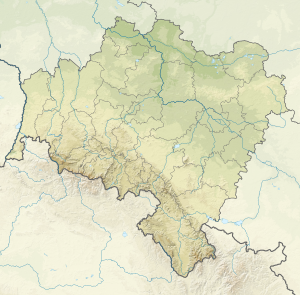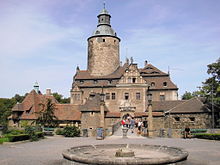Czocha Castle
| Czocha Castle | ||
|---|---|---|
|
Entrance area of the castle |
||
| Alternative name (s): | Zamek Czocha (pl.) | |
| Creation time : | around 1250 | |
| Castle type : | Höhenburg, hillside location | |
| Conservation status: | very good | |
| Standing position : | Knight's castle (fortress), rebuilt in the Renaissance style since the 16th century | |
| Construction: | Castle: granite fragments and gneiss, connected by lime mortar. | |
| Place: | Sucha , Leśna rural municipality | |
| Geographical location | 51 ° 1 ′ 50 " N , 15 ° 18 ′ 13" E | |
| Height: | 300 m npm | |
|
|
||
The Czocha Castle (Polish Zamek Czocha ) is a hilltop castle ( hillside castle ) in Sucha (Tzschochau) at Stankowice (Rengersdorf) , a district of the rural community Leśna (Marklissa) in Powiat Lubański in the province of Lower Silesia in Poland. It is four kilometers east of Leśna on the left bank of a promontory on the Queis river or the Marklissa dam .
history
The area of the later castle or rule Tzschocha belonged to the first Meissen , then Bohemian Gau Zagost . Later it formed the Upper Lusatian Queiskreis together with the castle districts of Lesne and Schwerta . The Tzschocha Castle was only built after 1241, after the boundaries between the possessions of the Diocese of Meißen and the Crown of Bohemia were contractually regulated in the Upper Lusatian border document . The castle was built either during the Bohemian or Ascanian rule over the Upper Lusatia and served to secure the border towards Silesia . It was first mentioned in a document as "Castle Caychow" in 1329. Before 1316 it was owned by the Bohemian King Wenceslaus II. He handed the castle over in 1316 as a dowry to his daughter Agnes / Anežka, who was married to Duke Heinrich I von Schweidnitz that year. Jauer was married. After her death in 1337, the castle passed to the widower Duke Heinrich. After his death in 1346 it coincided with the Queiskreis as a completed fief to the crown of Bohemia home .
Since the third quarter of the 14th century, the castle and the Tzschocha estate were owned by the Dohna family . From 1417 to 1419 both belonged to Heinrich Renke, then to the Imperial Councilor Hartung von Klüx. During his reign it was destroyed by the Hussite Wars . In 1451 the castle and the lordship came to the Nostitz family .
A wide strip of land to the left of the Queis between Greiffenberg and Marklissa belonged to the castle district of Tzschocha . After Hartmut von Klüx had acquired Friedersdorf on the right of the Queis in 1427 from the Hereditary Principality of Schweidnitz-Jauer , it was added to the Marklissa lordship and counted as part of the Queis circle.
After the Peace of Prague in 1635, the rule of Tzschocha fell to the Evangelical Electorate of Saxony together with the Queiskreis . This also made the rulership an immigration area for religious refugees from Bohemia and Silesia . The landlord Christoph von Nostitz founded the town of Goldentraum and the villages of Hagendorf , Goldbach , Scholzendorf and Karlsberg for them . The churches of Friedersdorf and Nieder Wiesa near Greiffenberg now served as border churches for Protestant Silesians. Refuge churches were built in Rengersdorf and Ober Wiesa . In 1703, the castle and rule of Tzschocha were acquired by Johann Hartwig von Uechtritz , whose descendants kept the property with one interruption from 1755 to 1782 (when the castle belonged to Otto von Schindel ) until 1910. In 1776 the lexicographer Carl Wilhelm Otto August von Schindel was born in the castle .
After the Congress of Vienna in 1815, the rule of Tzschocha fell to Prussia together with East Oberlausitz . The area has now been connected to the province of Silesia and incorporated into the Lauban district. From 1874 the castle district belonged to the district of Rengersdorf, which in 1908 consisted of the rural communities Goldentraum and Rengersdorf and the manor district of Tzschocha. In 1910 the castle complex was acquired by Ernst Gütschow, the general director of the Jasmatzi cigarette factory , who lived in the castle until the end of the war in 1945. As a result of the Second World War, the area fell to Poland in 1945.
Castle complex
The castle, which was destroyed during the Hussite Wars, was then rebuilt. In the 16th century, under Johann von Nostitz, a renovation and expansion was carried out in the Renaissance style into a large castle complex with a moat , farm buildings, kennel , keep, etc. Under Christoph von Nostitz, the damage caused by the Thirty Years' War was removed and a garden was created at the same time. The parts of the building damaged in a fire in 1793 were then rebuilt. In 1910 the castle was acquired by Ernst Gütschow. He arranged for a renovation in the neo-Gothic style by the castle builder Bodo Ebhardt . He had a copy of Hugo Lederer's fencing figure erected in the baroque garden .
After the transition to Poland in 1945 as a result of World War II, the castle suffered damage from looting. Since 1952 it served as a leisure center for military personnel. It has housed a hotel since 1996.
literature
- Lars-Arne Dannenberg , Matthias Donath : Castles in the Polish Upper Lusatia . edition Sächsische Zeitung Dresden, 2011.
- Dehio Handbook of Art Monuments in Poland Silesia . Munich • Berlin 2005, ISBN 3-422-03109-X , p. 545.
- Günther Grundmann : Castles, palaces and manor houses in Silesia - Volume 1: The medieval castle ruins, castles and residential towers . Verlag Wolfgang Weidlich, Frankfurt am Main 1982, ISBN 3-8035-1161-5 , pp. 67-69.
- Hugo Weczerka (Hrsg.): Handbook of the historical places . Volume: Silesia (= Kröner's pocket edition . Volume 316). Kröner, Stuttgart 1977, ISBN 3-520-31601-3 , pp. 107 and 424, pp. 108, 424 and 548f.
- Zschochau . In: August Schumann : Complete State, Post and Newspaper Lexicon of Saxony. 12th volume. Schumann, Zwickau 1825, pp. 72-74.
Web links
- www.bernievancastle.de: Castles and city walls in Europe Castle Tzschocha
- Information on Czocha Castle with descriptions of the individual rooms (PDF file; 565 kB)
- Picture gallery of the castle (status: 2005)
- Information about the castle: past and present
- Polish castle side above Czocha Castle
- Tzschocha (PDF; 390 kB), graphics and text in the " Duncker Collection "




